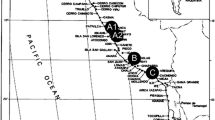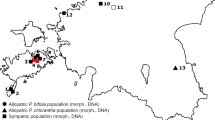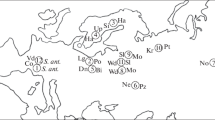Abstract
Cross-compatibility within and among populations of the perennialEriastrum densifolium was investigated to determine if sterility barriers have evolved within this polytypic species, and to correlate any such barriers to previously known patterns of genetic and morphological variation. Furthermore, the reproductive affinities of the endangeredE. densifolium subsp.sanctorum are investigated. Results indicate that no single population or group of populations is reproductively isolated from all other populations, and that F1 hybrids are fully fertile. Interspecific crosses (withE. eremicum andE. sapphirinum) were largely unsuccessful. The endangeredE. densifolium subsp.sanctorum demonstrates high interfertility with all other populations.
Similar content being viewed by others
References
Brunell, M. S., 1996: Biosystematics ofEriastrum densifolium (Bentham)Mason (Polemoniaceae). — Ph. D. Dissertation, University of California, Riverside.
, 1993: Genetic variation in the endangered Santa Ana River Woolly-Star,Eriastrum densifolium spp.sanctorum (Polemoniaceae). — Pl. Spec. Biol.8: 1–6.
, 1997: RAPD marker variation inEriastrum densifolium (Polemoniaceae): implications for subspecific delimitation and conservation. — Syst. Bot.22: 543–553.
Burk, J. H., Jones, C. E., Wheeler, J., DeSimone, S., 1988: The ecology ofEriastrum densifolium ssp.sanctorum (Milliken)Mason: final report. — Prepared for the department of the Army, Corps of Engineers (COE), Los Angeles District.
Clausen, J., 1951: Stages in the evolution of plant species. — Ithaca: Cornell University Press.
Craig, T., 1934: A revision of the subgenusHugelia of the genusGilia (Polemoniaceae). — Bull. Torrey Bot. Club61: 385–397.
Erickson, M., 1993: Optimal outcrossing and pollinator foraging distance in the Santa Ana River Woolly Star,Eriastrum densifolium ssp.sanctorum (Milliken)Mason (Polemoniaceae). — M. A. Thesis, California State University, Fullerton.
Fisher, R. A., 1930: The genetical theory of natural selection. — Oxford: Clarendon Press.
Grant, V., 1950: Genetic and taxonomic studies inGilia. I.Gilia capitata. — Aliso2: 239–316.
, 1954: Genetic and taxonomic studies inGilia. IV.Gilia achilleaefolia. — Aliso3: 1–18.
, 1966: The selective origin of incompatibility barriers in the plant genusGilia. — Amer. Naturalist100: 99–118.
, 1981: Plant speciation. 2nd edn. — New York: Columbia University Press.
Hamrick, J. L., Godt, M. J. W., 1990: Allozyme diversity in plant species. — InBrown, A. H. D., Clegg, M. T., Kahler, A. L., Weir, B. S., (Eds): Plant population genetics, breeding, and genetic resources, pp. 43–63. — Sunderland, MA: Sinauer.
Jepson, W. L., 1943: Flora of California.3, pp. 160–168.
Levin, D. A., 1978: The origin of isolating mechanisms in flowering plants. — Evol. Biol.11: 185–317.
Mason, H. L., 1945: The genusEriastrum and the influence ofBentham andGray upon the problem of generic confusion inPolemoniaceae. — Madroño8: 65–104.
Mayr, E., 1942: Systematics and the origin of the species. — New York: Columbia University Press.
Muñoz, A. A., 1991: Reproductive biology of the endangered Santa Ana River Woolly Star,Eriastrum densifolium ssp.sanctorum (Milliken)Mason (Polemoniaceae). — M. A. Thesis, California State University, Fullerton.
Munz, P. A., 1974: A California Flora and supplement. — Berkeley, Los Angeles: University of California Press.
Patterson, R. W., 1993:Eriastrum. — InHickman, J. C., (Ed.): The Jepson Manual: Higher Plants of California, pp. 826–828. — Berkeley, Los Angeles: University of California Press.
Rice, W. R., 1989: Analyzing tables of statistical tests. — Evolution43: 223–225.
Sokal, R. R., Crovello, T. J., 1970: The biological species concept: a critical evaluation. — Amer. Naturalist104: 127–153.
, 1995: Biometry: the principles and practice of statistics in biological research. 3rd edn. — New York: Freeman.
Stace, C. A., 1989: Plant taxonomy and biosystematics. 2nd edn. — London: Hodder & Stoughton.
Wallace, A. R., 1889: Darwinism: an exposition of the theory of natural selection. — London: Macmillan.
Author information
Authors and Affiliations
Rights and permissions
About this article
Cite this article
Brunell, M.S., Whitkus, R. Analysis of cross-compatibility inEriastrum densifolium (Polemoniaceae). Pl Syst Evol 215, 241–254 (1999). https://doi.org/10.1007/BF00984658
Received:
Accepted:
Issue Date:
DOI: https://doi.org/10.1007/BF00984658




